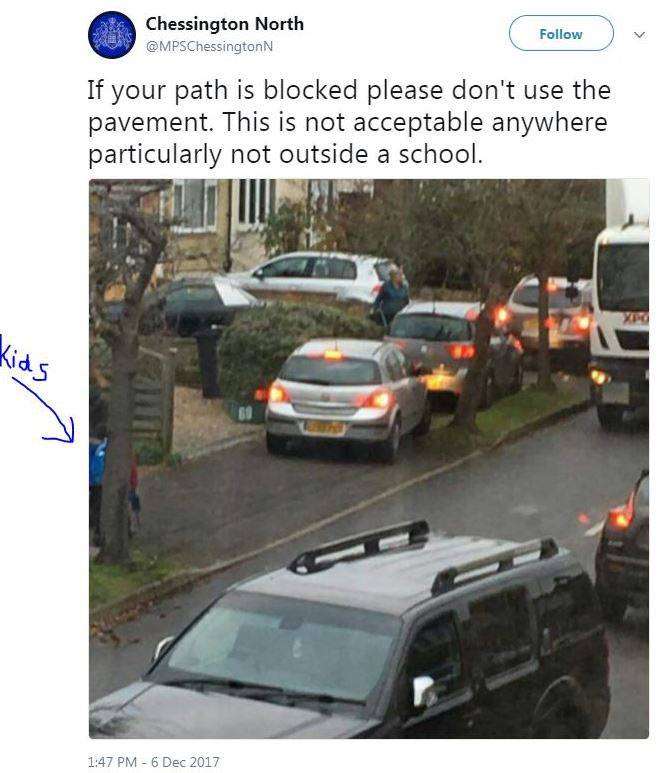
How do you feel about pavement parking? In an act of desperation five years ago, we invented this (spoiler alert: The problem’s even worse today).

CatClaw is the size of half a small orange and is designed to be installed in its thousands along kerbs and pavements. When a car or lorry drives over a CatClaw, its weight exposes a sharp steel tube that quickly punctures the tyre. However, it poses no threat to pedestrians – a person standing on top of the device would not be heavy enough to activate it.

If a car mounts a pavement fitted with the CatClaw, it’s tyres are quickly and efficiently burst
What’s the point of the CatClaw?
Clearly there are many reasons why the Catclaw cannot become a commercial product. However, something needs to be done to prevent illegal pavement parking and driving. Have a look at the photo below. Drivers faced with a blocked road ahead have taken to the pavement – forcing school children to take shelter in driveways.

It’s highly unusual for the subject of road danger to be covered objectively by the mainstream media, which is odd given the alarming frequency at which it claims the lives of children. When a four-year-old girl on a pavement in Liverpool was crushed to death in front of her mother by a driver who didn’t want to hold up traffic, the story was covered by local newspapers but failed to reach the national news agenda. At best, coverage of road danger is highly selective and almost always divisive.
The absence of a systematic approach to road danger reduction, the victim blaming of vulnerable road users and an absence of any meaningful public debate about hierarchy of road user rights prompted The ETA to launch the idea of the Catclaw – a retractable spike that punctures the tyres of cars that venture onto pavements illegally.
What is the point of the Catclaw?
The Catclaw is an extreme idea that is unlikely to be practicable, or even legal. Other than the sharpened spike hidden within, what, you may well ask, is its point. The purpose of the project is to highlight the plight of the 40+ people killed last year on pavements in Britain by drivers and the many thousands of pedestrians every day who have their path blocked. In other words, the Catclaw is a crafty way to discuss the need for road danger reduction with an extremely large audience.
The Catclaw allowed us to talk at some length on BBC Radio Scotland about the need to radically alter the way we tackle road danger in all its forms. Likewise, the project got us an invitation to a televised discussion about road danger that involved a serving member of Parliament. Elsewhere in the media, the project generated coverage in numerous titles including The Daily Mail, The Express, The Mirror, Metro, The Manchester Evening News…not to mention the tens of thousands of Twitter users who engaged with the story and the 195,000 folk on YouTube who watched our film about it.
The systematic approach to road danger reduction Britain so badly needs will not involve Catclaw or anything remotely as outlandish. As as happened in countries such as Sweden, it involves placing people’s needs ahead of cars. The benefits of such an approach are numerous, but include safer roads, reduced healthcare costs, greater independence for children and increased quality of life for all. However, change of this kind can occur only once people – as opposed to politicians – consider it vital. And that process starts with getting it talked about.
The ethical choice
The ETA was established in 1990 as an ethical provider of green, reliable travel services. Over 30 years on, we continue to offer cycle insurance (covers cargo bikes), breakdown cover and mobility scooter insurance while putting concern for the environment at the heart of all we do.
The Good Shopping Guide judges us to be the UK’s most ethical provider.

maggie williams
I have concerns about the cat claw, in an area with narrow streets we often need to pull up partially on pavement to let emergency vehicles through. Our main road (only road in and out) is constant traffic queue. Of course you check there is no one on pavement first.
As a wheelchair user who often needs to move over to let people pass what happens when I get a puncture and cannot continue.
It could also affect blind people or elderly who could trip on them.
Chris
Maggie Williams
Unless a wheelchair weighs as much as a car, a wheelchair user has no reason to fear the CatClaw, and many reasons to like them. Cat Claw is rated at 200kg.
Why? Quote [from the text above]: “When a car or lorry drives over a CatClaw, its weight exposes a sharp steel tube that quickly punctures the tyre. However, it poses no threat to pedestrians – a person standing on top of the device would not be heavy enough to activate it.”
Indeed pavement parking often blocks pavements, thereby forcing pedestrians, children and wheelchair users off the pavement and into the roadway.
It’s not only pavement parking, pavement driving and pavement overtaking
See youtube overtaking on pavement